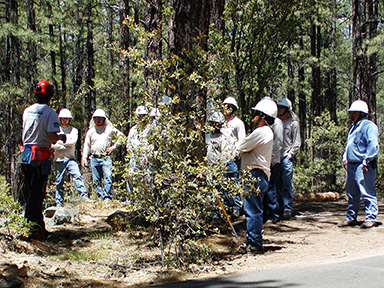Provided courtesy of North American Training Solutions
Modern tree care is a hazardous business. A hazardous job we can make dangerous by not wearing personal protective equipment (PPE) and following basic safety protocol. At the core of safety protocol lies planning for the unexpected and making sure the whole crew possess a thorough knowledge of the roles and responsibilities in the event all does not go as planned. Remember the old adage “Failing to plan is planning to fail.”

A good plan starts well before work ever does. Is all necessary safety equipment present and functioning? Fire extinguishers charged and ready? First aid kits stocked and accessible? Are they appropriate for the work and environment? Is PPE present and in use? Are all the tools/equipment necessary for the job and the skills to use them safely and efficiently present? Nothing disrupts job flow or makes a bad situation worse than needing a tool, skill or item of emergency equipment and not having it. Be sure the basics are covered before work begins.
Once the crew gets to the job location, review the work to be completed and identify the hazards and obstacles present. Get input from the whole crew and develop mitigation strategies as necessary. Put barriers in place to protect workers. Sometimes these barriers are physical such as chainsaw protective chaps or hard hats. Other times they are less tangible such as maximum approach distances for electrical conductors or voice command response systems between ground workers and climbers aloft. Whatever the barriers in use, be sure each and every crew member understands his or her role and all necessary job steps. Ignorance on the job site is not bliss; it is a hazard that must be accounted for and mitigated.
Place the job site address and emergency numbers in an agreed upon location; centrally located and easily accessible is best. If trucks or equipment must leave the site, make sure they have the necessary information and communications and ask yourself these questions:
- Does the area have 911 coverage?
- Is there enough mobile phone signal to make an emergency call?
- Is a land line available?
- How far is the nearest hospital and how easy will it be for an EMS crew to find your job site?
Writing down the emergency plan and mitigation strategies is a great way to reinforce communication and make sure all crew members are informed and understand. If the job task or situation changes, make sure the emergency plan and preparation change as well. Brief the crew with subsequent meetings as necessary.
A few simple steps and a solid plan can make the tree job safer and smoother. Knowing what to do in an emergency saves valuable time and energy when it is most important. Recognizing and planning for hazards is our first line of defense.
